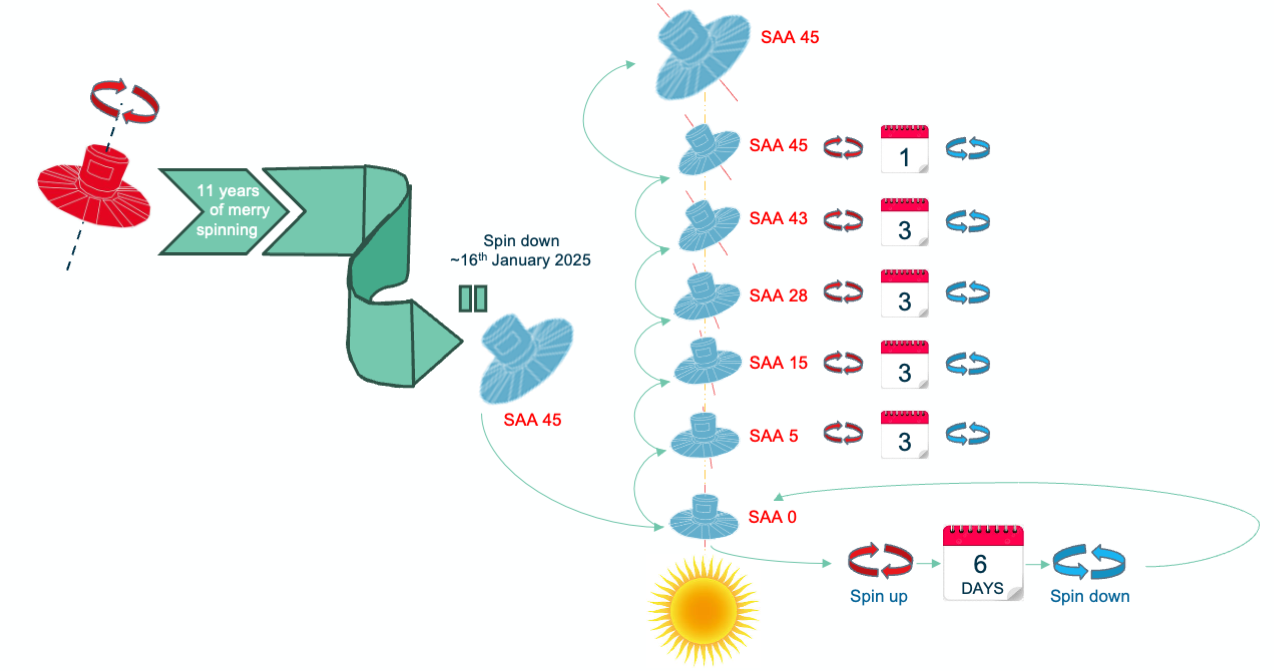Gaia end of observations - Gaia
Gaia spacecraft end of observations
The Gaia spacecraft relies on a cold gas propellant to keep it spinning and scanning the sky. The amount of remaining cold gas decreases by about a dozen grams per day and is reaching its end in early 2025. The Gaia science observations will therefore end on 15 January 2025, meaning that no more nominal science data will be acquired by Gaia after that date. This is, however, far from being the end of this transformative mission!
The Gaia scientific and engineering teams will continue to work full steam on the preparations for Gaia Data Release 4, which is not “more of the same” but will make new groundbreaking science possible by including a much larger data volume, many more data products, and data of overall better quality compared to Gaia Data Release 3. In the course of 2025, once all of Gaia’s nominal science data have been downlinked to Earth, the processing for the final Gaia Data Release 5 will ramp up to full speed and run in parallel to the processing of Gaia Data Release 4. Gaia Data Release 4, covering 5.5 years of mission data, is expected in 2026 and Gaia Data Release 5, covering the full 10.5 years of mission data, around the end of the decade.
After Gaia’s science observations end on 15 January 2025, a period of technology tests will commence. These technology tests will allow us to study in more detail the behaviour of some spacecraft and instrument components, with the potential of further improving the Gaia calibrations and aiding the design of future space missions. After these tests, which will last several weeks, the Gaia spacecraft will leave its orbit around the Lagrange point L2 to be put into its final heliocentric orbit, away from Earth’s sphere of influence. Eventually, the Gaia spacecraft will be passivated on 27 March 2025 and reach its well-deserved retirement.
More details on the different aspects of this final period for the Gaia spacecraft can be found below.
Gaia technology tests
An overview of the technology tests can be found from this page.
Citizen observations of the Gaia spacecraft
A follow-up campaign was organised and citizen astronomers have observed Gaia from across the world. Find some of these observations here.
Gaia spacecraft passivation and retirement orbit
After leaving its current orbit around the Lagrange point L2, Gaia will be inserted into an orbit that makes sure it does not come too close to the Earth-Moon system in the near future. The Gaia spacecraft will be fully passivated when it moves to its final orbit, to avoid any harm or interference with other spacecraft.
More details on the Gaia spacecraft passivation and the final heliocentric orbit is shared from this page.
Observe Gaia from the ground
During the technology tests Gaia will temporarily become brighter in the sky and imaging observations from the ground will therefore be a lot easier.
To follow-up from the ground, a good knowledge of where to find Gaia in the sky is essential. A tool called the Gaia ephemeris service is available to make predictions. It can derive topocentric ephemerides for every city worldwide above 100,000 inhabitants. The server is updated on a weekly basis.
Track where Gaia is in the sky with the Gaia ephemeris service (Use the FOV Public tab)
Find full details on how to observe Gaia from the ground, along with the schedule from the page:
Observe Gaia from ground
Gaia's expected attitude profile following the end of Gaia science observations on 15 January 2025. The planned timing may still change. Credits: ESA/Gaia/DPAC - CC BY-SA 3.0 IGO. Acknowledgements: Gaia Flight Operations Team.
Publications and events
News release: Last starlight for ground-breaking Gaia
Preparations are ongoing to mark the Gaia spacecraft passivation event. A news release will be published around 27 March.
Questions / Support
In case of questions, feel free to reach out to the Gaia Helpdesk.
- Removed a total of (5) style text-align:center;
- Removed a total of (6) style text-align:justify;








































 Sign in
Sign in
 Science & Technology
Science & Technology
